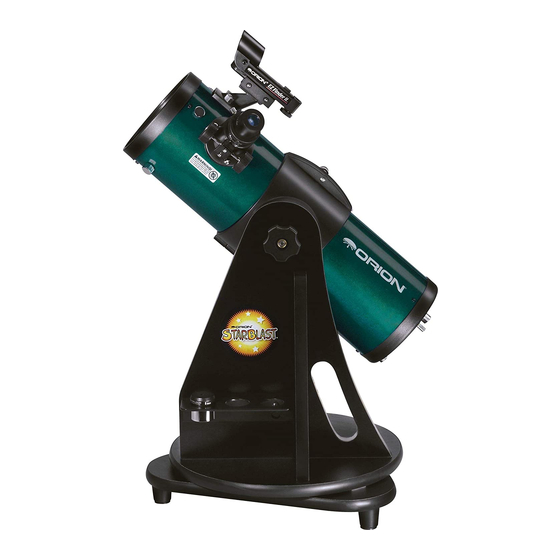
Orion StarBlast Instruction Manual
4.5
Hide thumbs
Also See for StarBlast:
- Instruction manual (12 pages) ,
- Instruction manual (5 pages) ,
- Instruction manual (8 pages)
Advertisement
Quick Links
Instruction Manual
Please read
this BEFORE
using
Telescope
Seaford Public Library
2234 Jackson Avenue
Seaford, NY 11783
(516) 221-1334
WARNING: Never look directly at the Sun through the telescope or its finder
scope — even for an instant — as permanent eye damage could result. Do not
point the telescope at the Sun, as parts will melt! Children should use this
telescope ONLY with adult supervision.
1
Advertisement

Summary of Contents for Orion StarBlast
- Page 1 Instruction Manual Please read this BEFORE using Telescope Seaford Public Library 2234 Jackson Avenue Seaford, NY 11783 (516) 221-1334 WARNING: Never look directly at the Sun through the telescope or its finder scope — even for an instant — as permanent eye damage could result. Do not point the telescope at the Sun, as parts will melt! Children should use this telescope ONLY with adult supervision.
-
Page 2: Table Of Contents
Table of Contents Page 3…. Telescope Parts Page 4…. Transporting the Telescope Page 4/5…. Care and Maintenance Page 5/6…. Getting Started/Setting up Page 6…. Focusing the Telescope Page 7/8…. Operating the Finder Scope/ What to Expect Page 8/9…. Objects to Observe Page 10….Sky Map (September 2021) Page 11…. -
Page 3: Telescope Parts
TELESCOPE PARTS: 1. Zoom Eyepiece 2. EZ Finder Scope (turn off when not in use) 3. Telescope tube 4. Focus wheels 5. Tube Clamp; loosen to rotate 6. Altitude Clamp (do not turn) 7. Mirror assembly (do not turn screws) 8. -
Page 4: Transporting The Telescope
TRANSPORTING THE TELESCOPE: The easiest way to carry the telescope is to place your forearm under the telescope tube when it is in a level position, and lift, holding the upright support against your side. When in a car, place the scope on a seat and use a seatbelt to secure it. The lap belt goes across the base, and the chest belt should cross the tube. -
Page 5: Getting Started/Setting Up
Fog on the mirrors and eyepiece: Please do not wipe the eyepiece with a tissue or cloth. One of the odd things that happens during stargazing is that dew forms on almost everything (and everyone). The big mirror is down at the bottom of the telescope and it does not get much dew. -
Page 6: Focusing The Telescope
Do You Wear Eyeglasses? If so, you will probably be able to observe with your glasses off by just refocusing the telescope to your unaided vision. If your eyes are astigmatic, images will probably appear best with glasses on. This is because a telescope’s focuser can accommodate for nearsightedness or farsightedness, but not astigmatism. -
Page 7: Operating The Finder Scope/ What To
making finding and centering an object much easier. With the eyepiece adjusted for low power (24mm), aim the telescope in the general direction of an object at least ¼ mile away. Slowly rotate the focus wheels until the object comes into sharp focus. Go a little bit beyond sharp focus until the image starts to blur again. -
Page 8: Objects To Observe
WHAT TO EXPECT: Depending upon what is in the sky; Planets will look small, but you might be able to see cloud bands on Jupiter or the rings of Saturn. Craters on the Moon will be clear and numerous, the waxing and waning of Venus should be visible, and many bright deep-sky objects will fill the eyepiece. - Page 9 Stars: Even powerful telescopes cannot magnify a star to appear as more than a point of light. You can, however, enjoy the different colors of the stars and locate many double and multiple stars. Look at the middle star in the handle of the Big Dipper, Mizar.
-
Page 11: When To Go Observing
WHEN TO GO OBSERVING “Seeing” and Transparency: Atmospheric conditions vary significantly from night to night. “Seeing” refers to the steadiness of the Earth’s atmosphere at a given time. In conditions of poor seeing, atmospheric turbulence causes objects viewed through the telescope to “boil.” In conditions of good seeing, star twinkling is minimal and images appear steady in the eyepiece. - Page 12 ADDITIONAL INFORMATION www.spaceweather.com https://astronomy.com/ www.eyesonthesky.com www.skymaps.com https://skyandtelescope.org/ https://www.education.slooh.com/parents BOOKS 101 Objects to See in the Night Sky– By: Robin Scagell Backyard Guide to Night Sky-By: Howard Schneider Complete Guide to Stargazing– By: Robin Scagell David Levy's Guide to the Night Sky– By: David H. Levy Patterns in the Sky: An Introduction to Stargazing By: Ken Hewitt-White The Practical Astronomer–...










